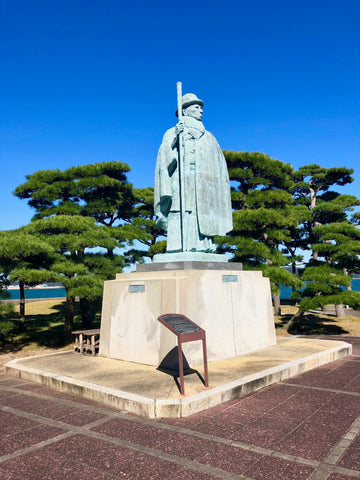 Pearls are a classic statement of elegance and refinement. The have been a coveted jewel since ancient times and only recently made available for mass consumption. This was due in large part to the efforts of Kokichi Mikimoto, also known as the father of cultured pearls. In the late 1800’s through laborious trial and error he developed a process for culturing pearls and thus eliminating the need to rely solely on the natural pearl supply. He is credited with developing the cultured pearl industry and bringing pearl jewelry to the masses.
Pearls are a classic statement of elegance and refinement. The have been a coveted jewel since ancient times and only recently made available for mass consumption. This was due in large part to the efforts of Kokichi Mikimoto, also known as the father of cultured pearls. In the late 1800’s through laborious trial and error he developed a process for culturing pearls and thus eliminating the need to rely solely on the natural pearl supply. He is credited with developing the cultured pearl industry and bringing pearl jewelry to the masses.
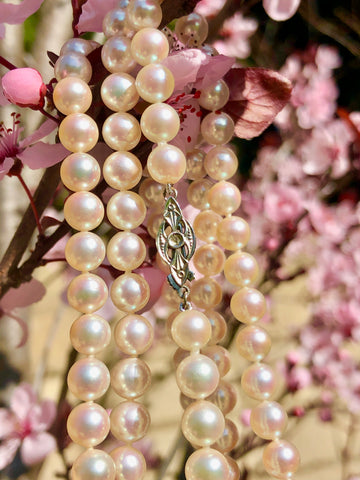
Natural vs. Cultured
The trade often uses the term cultured pearl or natural pearl, but what is the difference? A natural pearl is the result of no human intervention and is extremely rare and usually an off round shape. They can be found in oysters, clams, mussels, abalone, conch, and melo melo. This differs from cultured pearls which are dependent on human intervention. A shell bead or a piece of tissue is inserted into an oyster and they are returned to the sea allowing the mollusk to finish creating a cultured pearl which is typically a multi-year process.

Pearls have always been a popular jewelry ornament for thousands of years adorning rulers, monarchs, and the upper class. Natural pearls were exceptionally rare and often commanded the same worth as the most precious gemstones or diamonds. Many of the worlds pearls were harvested from Persian gulf where divers would undertake great personal risk to bring these gems to the surface. With the invention of the culturing process pearl diving has all but disappeared as mass production of pearls has taken over the waters of Japan, China, French Polynesia and Australia.
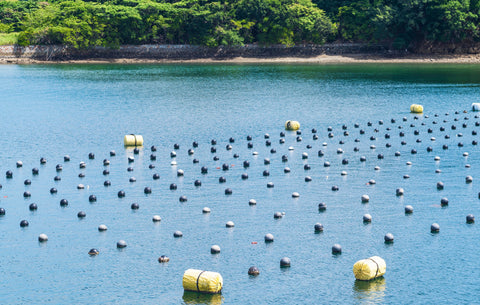
The pearl culturing process had a difficult beginning riddled with many failures, but where many have failed Kokichi Mikimoto succeeded. Born in 1858 in Toba, Japan to an udon shop owner, he realized at a young age he did not have a passion for udon, but discovered a hidden talent for business. Toba, being a coastal town, the ocean and fishing industries had a great impact on his early years. He watched the Ama (divers) bringing up pearls and other treasures of the sea and this began his lifelong fascination with pearls. He eventually opened his own pearl farm where he attempted to create the world's first round pearl. For years he was only able to produce hemispherical and off-round pearls, but one day in 1893 he succeeded. By inserting a mother of pearl bead, shaped from a freshwater mussel, found in the Mississippi River in the USA, and a small piece of mantle tissue from the oyster, he created the first round cultured pearl. This led to affordable and the increase in popularity of pearl jewelry. It also led to the development of the cultured pearl industry in the south seas, Australia and later China.
Types of Pearls
The classic strand of pearls is typically white, round and lustrous which is the embodiment of the Akoya pearl. But pearls come in many other shapes, sizes and colors.
Akoya Pearl

Akoya pearls are typically white, round, lustrous and luxurious. They are farmed in both Japan and China and range in quality and price. They can range from a few hundred to a few thousand per strand and are also used in rings, pendants and earrings. They are widely versatile and can be worn casually or to the most high end event.
Type: Saltwater, Pinctada fucata oyster
Location: Japan, China
Size: 2-11mm
Shape: Perfectly round to baroque
Color: White, Gold, Blue
Luster: High, mirror-like
Shape: Perfectly Round to baroque
South Sea Pearl
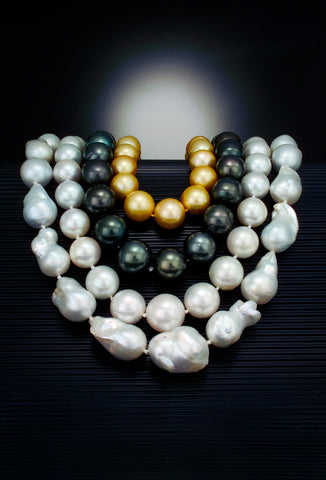
These pearls make quite a statement! They are much larger than Akoya pearls, but what they gain in size they loose in luster. They are grown in much warmer waters and have a softer satin luster. Due to their size they are also much more expensive than Akoya. A single strand ranges from around a thousand to many tens of thousands of dollars for a strand like the one pictured. They are a pearl for the serious collector, or someone looking to invest in jewelry. These pearls are cultured in the same way as Akoya pearls and started to be grown in the waters off of Australia in the 1950's. They have gained popularity with tourists and serious collectors alike.
Type: Saltwater, Pinctada maxima
Location: Australia
Size: 8-20mm
Shape: Round to baroque
Color: White, blue, orange, yellow, gold
Luster: Satin
Tahitian Pearls

These pearls offer a different and unique option from the traditional white pearls. They come in many colors including black, grey, brown, and green. Colors can be mixed and matched to create a totally unique look. As with south sea pearls the luster is still not as sharp as Akoya pearls, but these have wonderful multicolored overtones that make each pearl come alive. These strands also quite expensive, but baroque pearls are quite popular and can be had for a few hundred per strand. They gained recognition in the 1600's when explorers were enamored with the rare and unusual pearls the islander of French Polynesia possessed. It took a few hundred years, but around they started culturing these as well in the 1960's.
Tahitian
Type: Saltwater, Pinctada margaritifera
Location: French Polynesia
Size 9-14mm
Shape: Round to baroque
Color: Black, Grey, Brown, Green
Luster: Satin
Freshwater Cultured Pearls
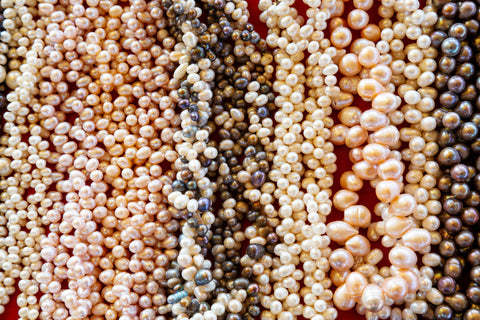
These are the newest type of cultured pearl on the market and have different characteristics from the saltwater types. They are grown in freshwater ponds in China and do not require a mother of pearl bead during the culturing process. This leads to the majority of product to be off-round, potato, and button shapes. They are also much easier to grow as a few dozen pearls can be cultured in a single mussel as apposed to a single pearl in saltwater mussels. These are a great starter strand due to their lower cost and wide availability. They often come in many pastel colors as well as the classic white. Each passing year these pearls come closer to traditional saltwater pearls in shape and color but due to the warm water they are grown in and the pollution prevalent in the country the luster does not even come close.
Type: Freshwater, Hyriopsis cumingi
Location: China
Size: 4-14mm
Shape: Mostly baroque or off round
Color: White, yellow, pink, purple, orange, green.
Note: Freshwater cultured pearls are commonly dyed.
Luster: Satin, improving with newer culturing processes
The Changing Industry
In today's market there are many choices of pearl jewelry for all tastes and budgets. While the traditional white strand is still the most desirable, colored freshwater pearls are an affordable choice since the 1990's. They offer a pop of color and class for a lower price point. Due to this popularity the freshwater culturing process has been growing exponentially over the past decade. They are creating new round, white pearls with few blemishes to compete with the saltwater Akoyas. While the quality has been improving there is still nothing like the mirror sharp luster and rosy warmth of a true Akoya pearl. Freshwater pearls are wonderful for everyday wear, but Akoya, a personal favorite of mine, are still the industry standard and what someone thinks of when picturing the classic luxury of white pearl jewelry.
Shop Vintage Akoya Pearl Strands





